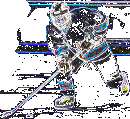The very first thing to learn is how to "stop" when you're on the ice. Gliding and moving forward are proverbial "no-brainers", compared with stopping, because the ice is slippery, and moving on it is easy. In fact, it's very hard not to be in motion on the ice. Every little twitch of your body and your legs will cause you to move in some direction. Stopping, on the other hand, requires "an opposite motion", and this can be hard until you become comfortable on your skates.
Snow Plow
The easiest "stop" to make on the ice is a "snow plow". As you're gliding forward, point your toes towards one another. The outside edges of your skates will grab the ice, causing you to slow down and eventually stop. This is a very standard stop, and I find that most hockey players just skip this, but if you're still getting comfortable on the ice, then practice this first.
T-Stop
The next easiest "stop" to make is the "T-stop". As you're gliding forward, take one foot off the ice, and lift it so that it's behind the gliding foot. Position this lifted foot perpendicular to the glide, and gently put it on the ice. The "T" that is formed will stop your movement.
Hockey Stop
The last "stop" is the hockey stop. As you're gliding forward, make a left turn with both feet, and as you're turning, lift yourself off the edges. This is cause you to glide forward, while facing left with your body. Then apply pressure on the edges, and you will be brought to a fairly sudden stop.
The last two stops (the "T" and the "hockey stop") should be practiced "in both directions." Stopping is really about applying an skating edge to the ice so that your movement stops. For inspiration, watch how the players or ice hockey referees come to a stop in a televised college or pro game. All of them can stop with one skate!
Finally, remember to keep your balance. After you get to a stop, your momentum may lurch your body forward. Bend your knees to strengthen the stop, and to lower your center of gravity.
